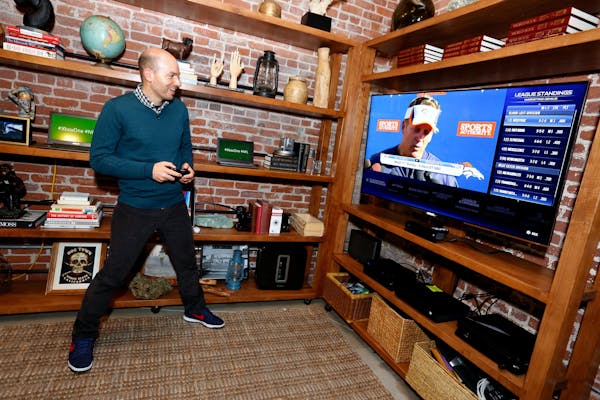Microsoft and Sony delivered new video game systems just in time for the holidays, but their moment in the spotlight may quickly be eclipsed by the growth of games on smartphones and tablets.
For the second week in a row, customers lined up early Friday for midnight sales at stores around the country as Microsoft Corp. rolled out the Xbox One. A week ago, Sony Corp.'s PlayStation 4 was introduced amid similar scenes of buyers waiting in lines.
But video game industry executives and analysts say the $400 PlayStation 4 and $500 Xbox One don't really threaten each other because they appeal to different fan bases that are already established. Both Sony and Microsoft should sell millions of units by the end of the year, analysts say.
The new consoles are arriving just as game-playing habits are changing. Sony and Microsoft "are releasing their next-generation video game consoles to a market that may be moving in another direction due to the popularity of mobile devices," Gartner, a market research firm, said in report last month.
Gartner predicts casual games on smartphones and tablets will account for 14 percent of worldwide video game software and console sales this year, compared with 12 percent last year. Two years from now, casual games will be 20 percent of the total video game market, Gartner predicts. In that time, the overall market is expected to grow from $93.3 billion to $111.1 billion.
Casual game sales still don't come close to combined console hardware and software revenue, which Gartner says will account for 47 percent of the worldwide video game market this year and rise to 50 percent two years from now.
Even so, the rise of casual games has the industry and retailers concerned, says Peter Warman, CEO of Newzoo, an industry market researcher.
"Microsoft and Sony both realize this, and are trying to increase their grip on money going around on the other screens," said Warman. "Retailers are worried, as they see the majority of money spent on [smartphone and tablet] games now take place through digital distribution or within the game in micropayments."
Game companies and retailers are also concerned about the time consumers are spending with casual games. Newzoo says U.S. game players spend 25 percent of their time playing casual games, but only 16 percent playing console games.
Casual games have hurt demand for games on PCs and handhelds more than advanced systems. Gartner predicts casual game sales will exceed PC game sales by 2015.
Michael Pachter, an analyst at Wedbush Securities in Los Angeles, said casual games "have taken the air out of handheld games, and to a great extent out of the [Nintendo] Wii, which is the de facto casual console."
If the PlayStation and Xbox were to be hurt by casual games, the market share of console games could drop quickly; each lost sale could easily represent $500 to $1,000 in unsold hardware and software.
But that appears unlikely for a while. "We will probably see a rebound of core game sales on PS4 and Xbox One to historical peak levels for each, meaning cumulative software sales growth of around 40 percent total over the next five years," Pachter said.
Sony said it sold more than 1 million PlayStation 4 consoles within 24 hours of its Nov. 15 launch, but analysts said that was largely the result of preorders filled on the first day. Late Friday, Microsoft matched Sony's numbers, saying it sold more than a million Xbox One consoles.
"There is absolutely a core audience for both consoles," said Chris Koller, vice president of entertainment and mobile electronics at Best Buy, which sells both the Sony and Microsoft machines. "The audience can get certain game content on one or the other."
Pachter expects the PlayStation 4 to outsell the Xbox One in the next 12 months because the PS4 is $100 cheaper. He predicts 10 million PlayStation 4 units will be sold compared with 8 million Xbox One units.
Microsoft says the Xbox One costs $100 more because it comes with the Kinect motion sensor that allows users to interact with the console. Microsoft says it can recognize players by their faces in addition to recognizing gestures.
Best Buy's Koller shrugs off the price difference. "There's a lot of pent-up demand for these consoles, and I don't see price as an obstacle," he said.
The price difference may matter next year, when the initial rush by game enthusiasts is over and more practical customer enters the picture.
"Core game enthusiasts are hardly price-sensitive," says Newzoo's Warman. "But price plays an important role in the second phase when Microsoft and Sony attempt to broaden the user base."
The Microsoft store at the Mall of America demonstrated some extra things the Xbox One does besides play games.
One is to allow a consumer to simultaneously play a video game and watch TV on the same screen, said Nicole Weber, a trainer at the Microsoft store. The unit will also recognize some voice commands, such as "on" to turn the machine on, and "record that" to save a video clip of a game in progress to share with friends. In addition, a fitness app will use the Kinect sensor to measure a user's heart rate based on color changes in the face.
Warman says game consoles will continue to be sold for years because some consumers will always want "the most immersive game experience."
"But time and money are becoming more equally divided" between serious and casual players, he said. "That ultimately puts pressure on the current share of wallet for consoles."
Steve Alexander • 612-673-4553
